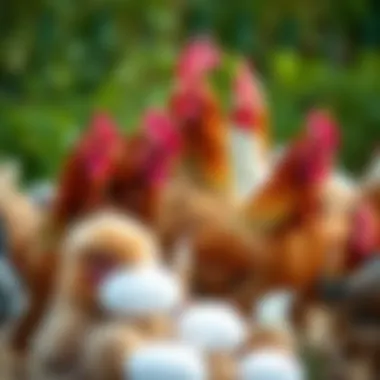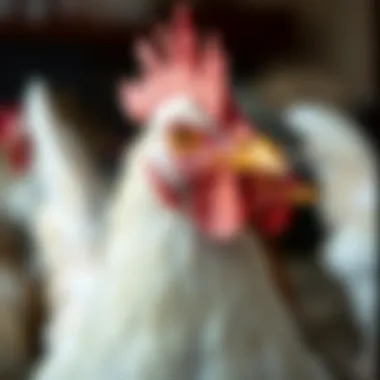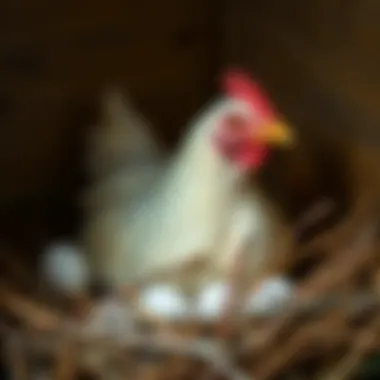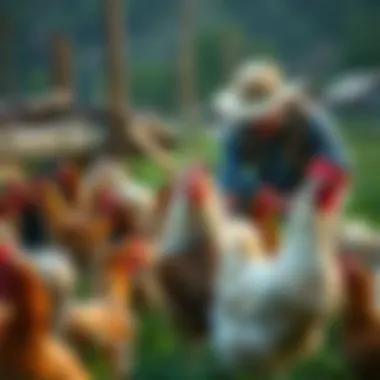Chicken Breeds: A Comprehensive Guide for Meat and Eggs


Intro
When you think about chickens, it's easy to picture a farm bustling with activity, yet beneath this lively scene lies the intricate world of chicken breeds. This guide zeroes in on breeds that serve a dual purpose—producing both meat and eggs. Raising chickens isn't just about collecting eggs or having a tasty roast; it's an art that balances productivity with the well-being of these feathered friends.
With many breeds out there, each with its own quirks and merits, knowing what to choose can feel like searching for a needle in a haystack. This article aims to demystify the subject, helping you manage livestock in a way that's sustainable while maintaining an emphasis on their care. As we dive in, you'll gain insights into how different breeds stack up against one another, alongside tips for their management and care to keep them happy and healthy.
Key Points to Discuss
- Characteristics of Dual-Purpose Breeds: What specific traits make certain breeds ideal for both meat and egg production?
- Optimal Management Practices: How can you effectively raise these breeds without compromising their welfare?
- Productivity and Welfare Balance: Ways to maximize output while ensuring the chickens’ needs are met.
- Real-Life Insights: Experiences from others in the community that can inform your choices.
This comprehensive examination aims to equip you—whether you're a sedate hobbyist or a full-blown poultry farmer—with the knowledge necessary to make informed decisions about the chicken breeds you choose. Understanding each breed's unique needs and traits will empower you to create a thriving environment for your birds.
Understanding the Goals of Poultry Farming
Poultry farming, especially when it comes to chickens, is not just about raising birds; it’s a multifaceted endeavor with several goals guiding farmers. In this section, we will delve into the core objectives that many poultry enthusiasts focus on. Understanding these goals is crucial, as they impact decisions related to breed selection, management practices, and ultimately, the overall success of the farming venture.
Defining Dual-Purpose Breeds
Dual-purpose breeds are an intriguing category in poultry farming, serving as a bridge between meat and egg production. Unlike specialized breeds that excel in one area, dual-purpose chickens are designed to offer an effective balance of both deployment options. This makes them particularly appealing to both small-scale farmers and hobbyists.
For instance, the Rhode Island Red and the Plymouth Rock are classic examples. They provide a respectable number of eggs while also producing sufficient meat for consumption. The versatility of these breeds allows farmers to make the most out of their space and resources. Choosing a dual-purpose breed means you do not need to commit entirely to one path, which can be particularly advantageous in fluctuating markets or personal consumption needs.
Economic Considerations
When considering poultry farming, economic factors can't be overlooked. The financial implications of selecting the right chicken breeds can significantly influence the sustainability of the operation. Here are a few elements to weigh carefully:
- Start-up Costs: Initial investment includes purchasing chicks, feed, and housing. Dual-purpose breeds often require less capital upfront than buying separate breeds for meat and egg production.
- Feed Efficiency: Different breeds have varying feed conversion ratios. It’s vital to select breeds that maximize growth and production while minimizing feed costs. Efficient feed use can substantially increase profits.
- Market Demand: Understanding your local market's demand for eggs or meat can redirect your focus. A breed that offers flexibility may help adapt to changing consumer preferences without the need for a complete overhaul of the farming system.
Through careful consideration of these economic factors, farmers can structure their operations to not just survive but thrive in the competitive world of poultry farming. The prospect of choosing dual-purpose breeds enriches the strategic playbook, allowing for greater adaptability and resilience in the face of market dynamics.
In summary, defining clear goals and understanding the economic landscape is pivotal for anyone serious about pursuing poultry farming. The choice of dual-purpose breeds is not just about preference; it’s about crafting an economically sound and sustainable poultry operation.
The Importance of Selecting the Right Breed
Selecting the appropriate chicken breed is vital for anyone involved in poultry farming. The breed you choose not only affects the production of meat and eggs but also influences management practices, health care, and overall farm productivity. The right breed can maximize the benefits of dual-purpose farming while ensuring that the chickens remain healthy and contribute positively to the ecosystem around them.
When considering chicken breeds, one must look at factors such as adaptability, feed conversion, and growth rates. These elements are not just numbers on a page; they are the bedrock of a successful farming operation. A well-selected breed will thrive under specific conditions, ensuring that your efforts yield substantial returns, be it in the form of eggs or meat. Thus, understanding each factor's nuances helps to tailor decisions that align with your farming objectives.
Factors to Consider
Choosing the right breed requires careful consideration of various factors that can significantly impact your operation. Let's delve into these aspects in more depth:
Climate Adaptability
Climate adaptability is a crucial aspect of selecting chicken breeds. Chickens evolved in diverse environments, and understanding a breed's adaptability to local climates can spell the difference between success and failure.
For instance, breeds like the Sussex or Rhode Island Red are known for performing well in various temperatures and conditions. This versatility makes them a popular choice for many chicken enthusiasts. One key characteristic of climate adaptability is the breed's feathering and size, which can impact heat retention or temperature regulation.
However, it's also beneficial for farmers to weigh the disadvantages. Some breeds may struggle in extreme conditions, leading to stress or health issues. Keeping these factors in mind will help farmers choose breeds that not only survive but thrive in their specific climate.


Feed Efficiency
Feed efficiency plays a significant role in the overall success of a poultry operation. It refers to how well a chicken converts feed into body mass or eggs. High feed efficiency means more production at a lower cost, which is often a farmer's goal.
Certain breeds, particularly commercial broilers, have been bred for exceptional feed conversion rates. For example, the Cornish Cross can put on weight rapidly, allowing for quicker returns on investment. Excellent feed efficiency is particularly beneficial for small-scale farmers looking to maximize limited resources.
On the flip side, it's essential to acknowledge that growth-focused breeds could require specialized diets, potentially increasing upfront costs. Balancing these considerations and finding breeds that align with specific production goals will lead to more informed decisions.
Growth Rate
Growth rate is another critical consideration when selecting chicken breeds. This trait indicates how quickly chicks reach market weight or sexual maturity. A faster growth rate can translate into quicker harvests, thereby maximizing profits for farmers.
Breeds like the Red Ranger or the Freedom Ranger are often cited for their rapid growth performance. These traits make them a preferred choice if speedy meat production is the goal. It's important to note, however, that certain fast-growing breeds may not have the best nutritional profiles or may require more intensive management.
Choosing a breed that strikes the right balance between growth rate and overall health is essential for sustainable farming practices.
Understanding Breed Characteristics
Grasping the characteristics of various breeds goes beyond numbers. It involves understanding their unique traits, behaviors, and adaptability to different farming environments. Not every breed will suit every farmer's needs; hence, it’s necessary to perform thorough research before making a choice. The blend of traits, from temperament to productivity, can enrich your poultry farming experience and lay the groundwork for long-term success.
Top Chicken Breeds for Meat Production
When it comes to poultry farming, the choice of chicken breed is crucial for meat production. Selecting the right breed not only impacts the quality and quantity of meat you get but also affects the overall efficiency of your farm. The right broilers can significantly reduce feed costs, offer faster growth rates, and provide consumers with tender, flavorful meat. In this section, we’ll dive into the leading chicken breeds that excel in meat production, exploring their unique benefits and characteristics.
Broilers
Broilers are the cream of the crop when it comes to meat production. These birds are specifically bred for rapid growth and high feed efficiency, making them a prime choice for farmers looking to maximize their meat yield.
Advantages of Broilers
The primary advantage of broilers lies in their ability to grow quickly, reaching market weight in as little as six weeks. This rapid growth timeline means that farmers can cycle their flocks more often, leading to increased overall production. Beyond just speed, broilers are also known for their impressive feed conversion ratio. They require less feed to gain a pound of body weight compared to many other breeds, which can significantly reduce feeding expenses. Additionally, broilers are generally easy to manage, as they thrive in various environments, whether industrial or backyard settings.
One unique feature of broilers is their juicy, tender meat that appeals to a broad range of consumers, from family dinners to upscale restaurants. However, it's worth noting that the intensive breeding for size may come with potential health issues, like leg weakness in some cases.
Common Varieties
Within the broiler category, there are several common varieties, each with its own characteristics tailored for specific production goals. The Ross 308 is widely recognized for its efficiency, producing a large amount of meat quicker than many other breeds. On the other hand, the Cobb 500 is well-regarded for its excellent feed conversion and adaptability to varying climates.
The unique feature of these varieties is that they can be raised with minimal care if the right conditions are provided. That said, the reliance on these hybrid strains can reduce genetic diversity, leading to vulnerability in disease outbreaks or market fluctuations.
Heritage Breeds
Heritage breeds are often seen as the antidote to the intensive broiler system. Although they don’t reach market weight as rapidly as broilers, they offer qualities that traditional or organic markets value highly.
Characteristics of Heritage Breeds
Heritage breeds grow at a natural rate, which contributes to a richer flavor and texture in the meat. Birds like the Bourbon Red or the Delaware are known for their hardiness and adaptability. Their slower growth rates allow for better bone development and a more robust body structure, making them popular in sustainable farming practices. Additionally, these breeds tend to have greater resistance to diseases compared to their hybrid counterparts.
However, farmers might face challenges with longer production cycles, which could lead to a longer time before realizing profit from these birds.
Sustainability Considerations


When examining sustainability, heritage breeds are a preferred choice for many commercial organic farms. These birds require less intensive care and contribute to biodiversity on the farm. Their natural behaviors are more pronounced, which can lead to healthier animals and a better-quality meat product overall.
The challenge with heritage breeds often lies in their market niche; while they are increasingly sought after for their quality and taste, educated consumers may be required to pay a premium price. This can limit their market reach compared to the more mainstream broilers.
Growth Rates and Feed Conversion
Understanding the growth rates and feed conversion for different breeds is key for any poultry farmer. Broilers typically convert feed to meat more efficiently than heritage breeds, making them a popular go-to for those focused exclusively on meat production.
However, heritage breeds may offer advantages in flavor, sustainability, and marketability. Farmers need to weigh these factors carefully when planning their poultry production strategy, as the choice ultimately depends on both personal values and economic goals.
As the poultry industry evolves, having a deep understanding of these various traits and characteristics can help farmers make informed decisions that align with their objectives, whether they prioritize speed, sustainability, or flavor.
Top Chicken Breeds for Egg Production
The selection of egg-laying breeds is paramount in achieving a sustainable poultry farming operation. Egg production serves as a significant source of income for both small-scale and commercial farms. Understanding the characteristics and strengths of various chicken breeds can help farmers make informed decisions that cater to their needs. Certain breeds excel in volume and quality of eggs while others may be more adaptable to specific farming conditions. The focus here will be on the most popular types of layers that provide both dependable egg production and optimal health.
Layer Breeds
Commercial Layer Varieties
When looking at commercial layer varieties, several key points stand out. These birds are particularly bred for high egg yield and efficiency. One prime example is the White Leghorn, known for its prolific egg-laying ability. These resilient birds can produce around 300 to 350 eggs per year under favorable conditions. The main advantage of commercial layers is their high feed conversion rate, enabling them to transform feed into eggs more efficiently than most dual-purpose varieties.
Their propensity for consistent egg production aligns perfectly with commercial goals. However, the downside lies in their less robust bodies which can lead to increased healthcare costs down the line due to their susceptibility to certain health issues.
Backyard Layers
On the flip side, backyard layers offer a different set of benefits. These breeds, like the Rhode Island Red or Sussex, are often favored for their hardiness and favorable temperament. They generally produce fewer eggs compared to commercial layers—typically around 200 to 250 eggs per year—but they shine in other areas. Their adaptability to varied living conditions makes them a popular choice for hobbyists or small-scale farmers.
Additionally, this breed's unique trait lies in their ability to thrive in free-range environments. They're not just egg producers; they contribute to a holistic farm ecosystem. While their lower production may seem a disadvantage, many backyard farmers appreciate the quality of eggs they lay, which can have higher nutritional value compared to mass-produced eggs.
Egg Production Rates
Understanding egg production rates is vital to maximizing the efficiency and profitability of any poultry operation. Layer breeds generally have specific peak periods, often in their first year, where they can produce eggs at their highest rates. Maintaining a favorable environment—through proper nutrition, adequate lighting, and sufficient space—ensures that layers can perform at their best. Additionally, being aware of seasonal changes can affect laying patterns, making it crucial to monitor fluctuations in egg output closely.
Egg production isn't just a numbers game; how these birds are managed plays an integral role in their laying habits. Integrating comprehensive management practices will not only enhance production but also promote overall bird health, something that ethical farmers must prioritize.
Managing Chickens for Optimal Production
Managing chickens effectively is crucial in order to achieve both meat and egg production goals. This section sheds light on the various factors influencing chicken management, including nutritional needs, housing, space requirements, healthcare, and biosecurity measures. Proper attention to these aspects ensures that poultry farmers don't just maximize production, but also uphold the welfare of the chickens.
Nutritional Needs
Balancing Diets for Meat and Eggs
Balancing diets for meat and eggs is a pivotal element in dual-purpose chicken farming. This balance significantly affects growth rates and egg quality, which are essential for overall production. Chickens require a diet that's rich in protein, energy, vitamins, and minerals. For layers, a calcium-rich diet aids in strong eggshell production, while broilers need higher protein for muscle development.
A well-balanced diet enhances feed efficiency. If birds don't get enough of the right nutrients, their production can plummet, leading to wastage and financial loss. So, considering both meat and egg production in diet formulation is a practical choice for this guide. Moreover, adjusting diets based on the age and production stage is beneficial. A unique feature of balancing diets is the ability to modify formulations based on observed performance, which provides flexibility.
Supplementation Guidelines


Supplementation guidelines play a crucial role in enhancing the nutritional profile of chicken feed. Using supplements can help fill the gaps in a chicken's diet. Common supplements may include probiotics, vitamins, and minerals. They are a popular choice as they can significantly boost the immune system and overall health of chickens.
The unique advantage of supplementation is the tailored approach to nutrition. For example, older hens may need different vitamins compared to younger pullets. On the flip side, over-supplementing can lead to waste and increased production costs. A careful assessment of each flock's health is needed to strike a balance.
Housing and Space Requirements
Coop Design Considerations
Coop design considerations are essential for creating a safe and comfortable living environment for chickens. A well-designed coop not only protects birds from predators but also promotes good ventilation and adequate space. Good airflow reduces the risk of respiratory issues, while enough room helps prevent stress and aggression.
Designing a coop that allows easy cleaning and maintenance is a key characteristic that can streamline the daily chores of a poultry farmer. It makes daily management much smoother, allowing you more time to focus on other important aspects of chicken care. One downside might be the initial investment in building a robust structure, but it pays off in the long run by safeguarding your birds.
Outdoor Access
Outdoor access can significantly enhance the physical and mental wellbeing of chickens. Allowing chickens to roam outside supports natural behaviors such as foraging and scratching, which are vital for their development. This characteristic is beneficial since happy and active chickens generally exhibit better health and productivity.
However, outdoor access may introduce challenges, such as exposure to harsh weather or predation. Careful planning in design is critical to offer outdoor freedom without compromising safety. Utilizing mobile chicken coops or “chicken tractors” can be a unique solution to balance both outdoor access and protection.
Healthcare and Biosecurity
Vaccination Protocols
Vaccination protocols are essential in safeguarding the flock against various diseases. Implementing a comprehensive vaccination schedule helps prevent outbreaks that can ravage populations, resulting in economic losses. This is a key part of a proactive healthcare approach and a practical choice for maintaining productivity.
A unique aspect of vaccination is that it not only protects individual birds but safeguards the entire flock's health. However, it's vital to follow proper guidelines; administering incorrect dosages or vaccines can do more harm than good. So, staying informed on recommended protocols is crucial for your birds’ safety.
Common Health Issues
Addressing common health issues is a necessity for maintaining an efficient poultry operation. Chickens can suffer from various ailments such as respiratory disorders, parasites, and nutritional deficiencies. Identifying symptoms early can make a significant difference in terms of treatment costs and recovery time.
The key to managing health issues lies in regular monitoring of flock condition and behavior. By keeping a close eye on your chickens, you can detect problems before they escalate. While it may seem burdensome at first, becoming familiar with common concerns can actually enhance your production and protect your investments. Ignoring these issues, however, could result in decreased egg production or slower growth rates for meat birds, clearly thwarting your production aims.
"An ounce of prevention is worth a pound of cure" - This is especially true in the realm of poultry management, underscoring the need for vigilance in health monitoring and preventive measures.
In summary, the management of chickens for optimal production encompasses nutrition, housing, health care, and biosecurity, each playing its part in the bigger picture of a successful poultry enterprise.
Evaluating Breeds: Epilogue and Recommendations
The journey through the fascinating world of chicken breeds reveals the importance of carefully evaluating factors that influence productivity and sustainability in poultry farming. Understanding which breeds excel in both meat and egg production can make all the difference for farmers and enthusiasts. This section ties together the significant points discussed throughout the article, emphasizing a methodical approach to choosing the right breed based on individual needs and goals. In the ever-evolving landscape of poultry farming, making informed decisions is paramount, and the recommendations provided here aim to streamline that process.
Summary of Key Traits
When selecting a chicken breed for dual purposes, it's crucial to focus on several key traits:
- Meat Quality: Look for breeds known for their flavorful and tender meat. The quality of meat can vary widely depending on genetics, so thorough research pays off.
- Egg Production Rates: Each breed brings different egg-laying capabilities. It's essential to know the average egg production numbers to meet your goals.
- Hardiness and Adaptability: Breeds that can withstand various climates and environmental conditions are often more resilient. Understand the climate you are farming in and choose breeds accordingly.
- Behavioral Traits: Some chickens are more docile than others, making them easier to manage. Consider how temperament will affect your farming experience.
- Feed Efficiency: Optimal growth rates and feed conversion ratios can impact your bottom line. Assess the important aspect of how much feed a breed requires to gain a certain amount of weight.
Analyzing these characteristics will provide clarity on which breeds might fit best within your farming framework, ensuring a successful venture in dual-purpose poultry raising.
Making the Right Choice
The choice of chicken breed can significantly affect productivity and overall satisfaction in poultry farming. Here are essential points to keep in mind when making that decision:
- Assess Your Goals: Clearly define whether your primary focus is on meat, eggs, or both. Different breeds cater to distinct objectives, thus aligning your efforts with your farming ambitions is essential.
- Research Breeds: Familiarize yourself with both common and less-known breeds, weighing their merits and drawbacks with respect to your specific needs. Resources such as Wikipedia and Britannica can serve as valuable references.
- Start Small: If you're a novice, consider starting with a small flock. This smaller scale allows for more manageable learning and adjustments based on your observations.
- Consult Fellow Farmers: Engaging with experienced poultry farmers on forums like Reddit can provide insights that textbooks may overlook. Hands-on experiences often share valuable lessons.
- Consider Welfare: Always prioritize the welfare of the animals. Understanding breed-specific health needs is crucial for preventing common issues that can arise, ensuring a happier and more productive flock.
"Farmers who prioritize thorough research often find that their overall yield and satisfaction improve significantly."
Ultimately, the choice of breed should resonate not only with economic goals but also with a commitment to maintaining a sustainable and happy environment for the chickens. Evaluating and recommending breeds based on individual farming contexts can pave the way for thriving poultry operations.







